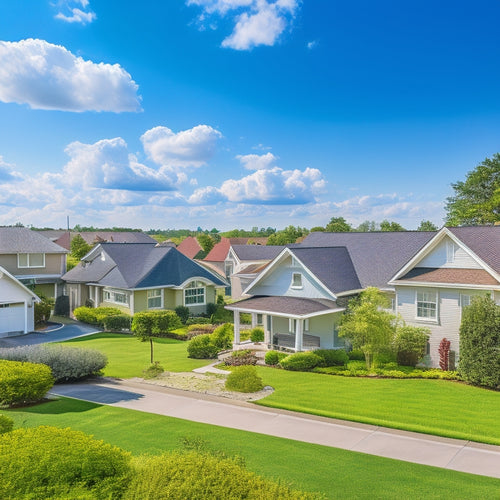
Why Consider Sustainable Insulation for Your Home?
Share
You're making a significant investment in your home, and choosing the right insulation can have a lasting impact on your wallet, your health, and the planet. Sustainable insulation offers numerous benefits, including improved energy efficiency, reduced environmental impact, and enhanced indoor air quality. By adopting eco-friendly insulation materials and practices, you can save up to 60% on energy bills, increase your property value, and breathe easier knowing you're contributing to a healthier planet. As you assess your options, you'll uncover a world of innovative materials and incentives that can help you make a positive impact - and reap the rewards.
Key Takeaways
- Sustainable insulation reduces energy consumption, saving 30-60% on energy bills and contributing to a reduced carbon footprint.
- Eco-friendly insulation materials like wool, hemp, and recycled denim promote a healthier indoor environment and minimize environmental impact.
- Homes with sustainable insulation features attract environmentally conscious buyers, potentially increasing property value and recouping investments.
- Sustainable insulation practices support long-term environmental goals, energy independence, and a reduced strain on natural resources.
- Government incentives, tax credits, and rebates are available to offset the higher upfront costs of sustainable insulation, making it a more accessible option.
Benefits of Sustainable Insulation
Because you're considering sustainable insulation for your home, you're likely wondering what benefits it can bring. One significant advantage is improved thermal performance, which means your home will stay cooler in the summer and warmer in the winter. This results in lower energy bills and a reduced carbon footprint.
In addition, much like electric vehicles that lower operating costs, sustainable insulation can also lead to long-term cost savings. Sustainable insulation also allows for more flexible installation techniques, making it easier to work around obstacles like pipes and electrical wiring.
Moreover, sustainable insulation can increase your home's value and appeal to environmentally conscious buyers if you decide to sell. By choosing sustainable insulation, you'll enjoy a more comfortable, energy-efficient living space that aligns with your values of freedom and environmental responsibility.
Eco-Friendly Insulation Materials
You're likely wondering what eco-friendly insulation materials are available for your home.
When selecting materials, it's crucial to evaluate the energy efficiency of your insulation, much like optimizing your solar panel array design optimal energy generation.
You can choose from natural fiber options like wool, hemp, or cotton, which are biodegradable and non-toxic.
Additionally, you can opt for insulation made from recycled materials, which reduces waste and has a low carbon footprint.
Natural Fiber Options
How effectively do natural fibers insulate your home while also being eco-friendly? Natural fibers are a great option for those looking for sustainable insulation.
These eco-friendly materials come from various fiber sources, such as plants, trees, and even recycled clothing. They can also be powered by renewable energy sources like solar and wind, reducing reliance on traditional grid electricity renewable energy sources.
Additionally, sustainable charging solutions can be integrated into homes with natural fiber insulation, providing a thorough eco-friendly approach.
-
Renewable resource: Natural fibers are sourced from replenishable resources, reducing the reliance on synthetic materials.
-
Carbon sequestration: Some natural fibers, like hemp, absorb more CO2 during growth than is emitted during production.
-
Low embodied energy: Natural fibers require less energy to produce than traditional insulation materials.
- Easy installation: Natural fibers can be installed using various techniques, including batts, blankets, and loose-fill methods.
When considering natural fiber insulation, research the best fiber sources and installation techniques for your specific climate and building type.
Recycled Materials Used
Many homeowners are turning to recycled materials as a sustainable insulation solution. You can join them by exploring eco-friendly options that benefit the environment.
Recycled denim, for instance, is a popular choice. It's made from old jeans that would have otherwise ended up in landfills. This insulation material isn't only sustainable but also provides excellent thermal performance.
In addition, using solar-powered EV charging stations Fast Charging Infrastructure can further reduce carbon footprint and promote energy independence.
Another option is reclaimed wood, which reduces waste by repurposing wood from old buildings or trees.
Low Carbon Footprint
Incorporating eco-friendly insulation materials into your home's design is a significant step towards reducing your carbon footprint. By choosing sustainable insulation options, you're not only minimizing your impact on the environment, but also promoting renewable resources and sustainable practices.
Additionally, using renewable energy solutions, such as solar panels, can further reduce your reliance on fossil fuels and lower your carbon footprint. Incorporating green hydrogen fuel cells, which offer durability and lower maintenance costs, can also be a viable option.
Here are some eco-friendly insulation materials to contemplate:
-
Recycled denim insulation: Made from recycled denim jeans, this insulation is a creative way to reduce waste and promote sustainability.
-
Bamboo insulation: Bamboo is a highly renewable resource that's lightweight, durable, and resistant to pests and mold.
-
Wool insulation: Natural wool insulation is a sustainable alternative to traditional fiberglass insulation, providing excellent thermal performance.
- Cellulose insulation: Made from recycled paper products, cellulose insulation is a cost-effective and eco-friendly option for your home.
Reducing Carbon Footprint Impact
By choosing sustainable insulation, you're taking a significant step in reducing your home's carbon footprint.
You'll lower emissions now, creating a more energy-efficient home that reduces its impact on the environment.
Lower Emissions Now
As you wrap your hands around a steaming cup of coffee on a chilly winter morning, the last thing on your mind is the environmental impact of your cozy home.
However, traditional insulation materials can contribute to greenhouse gas emissions. By choosing sustainable insulation, you can reduce your carbon footprint and create a more environmentally friendly living space.
Here are some benefits of sustainable insulation:
-
Improved energy performance: Sustainable insulation materials reduce heat loss, keeping your home warm in winter and cool in summer.
-
Enhanced thermal comfort: You'll enjoy a consistent indoor temperature, ensuring a comfortable living space for you and your family.
-
Lower emissions: Sustainable insulation materials have a lower carbon footprint, reducing your home's overall environmental impact.
- Increased freedom: By reducing your reliance on non-renewable energy sources, you're contributing to a cleaner, healthier environment for future generations.
Energy Efficient Homes
Your home's energy efficiency is an essential factor in reducing its carbon footprint impact. By incorporating sustainable insulation, you can markedly decrease the energy consumption of your home. This not only helps the environment but also saves you money on energy bills.
When building or renovating your home, consider investing in smart home technologies that can optimize energy usage. Building renovations are an excellent opportunity to upgrade to energy-efficient materials and appliances.
Greenhouse Gas Reduction
Beyond the obvious benefits of saving energy and money, sustainable insulation plays a critical role in reducing greenhouse gas emissions that contribute to climate change.
By choosing sustainable insulation, you're doing your part to mitigate the devastating effects of climate change. Here's how:
-
Reducing carbon footprint: Sustainable insulation helps reduce the amount of energy needed to heat and cool your home, resulting in lower greenhouse gas emissions.
-
Promoting insulation innovation: The demand for sustainable insulation drives innovation, leading to more eco-friendly products and installation methods.
-
Conserving natural resources: Sustainable insulation often uses recycled materials, reducing the strain on natural resources and minimizing waste.
- Creating a healthier environment: By reducing your carbon footprint, you're contributing to a healthier environment and a more sustainable future for generations to come.
Lower Energy Consumption Costs
By installing sustainable insulation in your home, you'll be taking a significant step towards reducing your energy consumption costs. This means you'll enjoy energy savings and cost efficiency, giving you more freedom to allocate your resources as you see fit.
| Insulation Type | Energy Savings | Cost Efficiency |
|---|---|---|
| Fiberglass | 30-40% | Moderate |
| Cellulose | 40-50% | High |
| spray foam | 50-60% | Very High |
| Recycled denim | 30-40% | Moderate |
With sustainable insulation, you'll notice a significant decrease in your energy bills, allowing you to allocate that money towards other important aspects of your life. By choosing sustainable insulation, you're not only reducing your energy consumption costs but also contributing to a more environmentally friendly home.
Healthier Indoor Air Quality
In harmony with reduced energy consumption, sustainable insulation also plays an essential role in maintaining healthier indoor air quality. By reducing air leaks and preventing moisture buildup, sustainable insulation helps to minimize the presence of indoor pollutants. This is especially important since the average person spends around 90% of their time indoors.
Here are 4 ways sustainable insulation improves indoor air quality:
-
Reduces pollen and allergens: Sustainable insulation keeps outdoor allergens from entering your home, creating a healthier environment for you and your family.
-
Minimizes moisture buildup: By preventing moisture from accumulating in your walls and ceiling, sustainable insulation reduces the growth of mold and mildew.
-
Improves ventilation systems: Sustainable insulation works in tandem with your home's ventilation systems to circulate fresh air and remove stale air.
- Eliminates chemical emissions: Many sustainable insulation materials are free from harsh chemicals, reducing the emission of volatile organic compounds (VOCs) in your home.
Increased Property Value Impact
With sustainable insulation, your home's value gets a significant increase.
A property appraisal will likely reflect this enhancement, as eco-friendly features are in high demand. In today's market, buyers are willing to pay a premium for homes that reduce their carbon footprint.
Sustainable insulation not only saves energy but also provides a competitive edge when selling your property. As market demand for eco-friendly homes continues to grow, your investment in sustainable insulation will pay off.
You can expect to recoup your investment and potentially even increase your asking price. With sustainable insulation, you're not only doing your part for the environment, but you're also making a smart financial move.
Meeting Green Building Standards
Many sustainable insulation materials meet or exceed green building standards, such as LEED and Energy Star.
By choosing sustainable insulation, you're not only reducing your environmental footprint but also guaranteeing your home meets rigorous green building standards. This can lead to green certifications, which can increase your property value and provide a sense of satisfaction in your eco-friendly home.
To meet green building standards, consider the following:
- Building codes: Confirm your insulation meets local building codes and regulations.
- Material selection: Choose insulation materials with low embodied energy and recycled content.
- Thermal performance: Select insulation with high R-values to minimize heat loss and gain.
- Indoor air quality: Opt for insulation that promotes healthy indoor air quality by minimizing VOCs and moisture buildup.
Government Incentives Available
Across the United States, you can tap into various government incentives that reward homeowners for choosing sustainable insulation, thereby offsetting the higher upfront costs associated with eco-friendly materials. These incentives can considerably reduce the financial burden of switching to sustainable insulation.
| Incentive Type | Description |
|---|---|
| Tax Credits | Federal tax credits of up to $500 for qualified energy-efficient improvements, including insulation upgrades |
| Rebate Programs | State and local rebate programs offering cashback for sustainable insulation installations, varying by location |
| Energy Efficiency Grants | Competitive grants for homeowners and builders implementing sustainable insulation solutions in new construction or retrofit projects |
Frequently Asked Questions
Can I Install Sustainable Insulation Myself or Do I Need a Professional?
Installing sustainable insulation is like maneuvering through a puzzle, and you can try DIY installation, but if you're not handy, it's like forcing a square peg into a round hole - consider seeking professional assistance to guarantee a snug, efficient fit.
How Long Does Sustainable Insulation Typically Last Before Replacement?
You'll find sustainable insulation typically lasts 20-50 years, depending on longevity factors like material quality, installation, and climate. Keep an eye out for replacement indicators like reduced R-value, mold, or pest infestations to guarantee your insulation remains effective.
Are Sustainable Insulation Materials More Expensive Than Traditional Options?
Get ready to break the bank, right? Not quite. While sustainable insulation materials may cost more upfront, you'll save in the long run with lower energy bills, making the cost comparison a no-brainer.
Can Sustainable Insulation Be Used in Older or Historic Homes?
You can definitely use sustainable insulation in older or historic homes, ensuring historic preservation while choosing from various insulation types like recycled denim, wool, or fiberglass, which won't compromise the home's original character or integrity.
Does Sustainable Insulation Provide Adequate Soundproofing Benefits?
You'll be pleased to know that sustainable insulation often provides excellent soundproofing benefits due to its high sound absorption capabilities, and the material's effectiveness in reducing noise pollution is a major advantage, giving you the peace and quiet you crave.
Related Posts
-

What Cool Roof Tax Breaks Can Homeowners Claim?
You can claim federal tax credits of up to $500 and state and local incentives for installing cool roofs, which not o...
-

7 Best Home Hydrogen Fuel Cells for Clean Power
You're considering adopting hydrogen fuel cells for clean power at home, but you want to know the best options. Reput...
-

7 Top HEPA Filters for Green Building Projects
You need a reliable HEPA filter for your green building project that aligns with your sustainable goals and guarantee...


